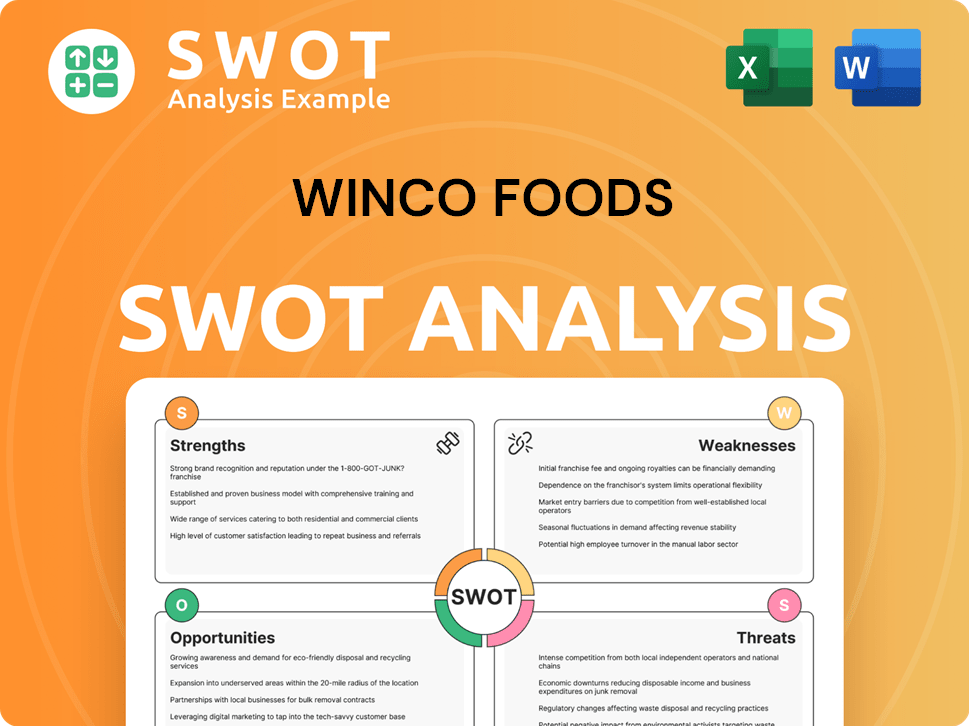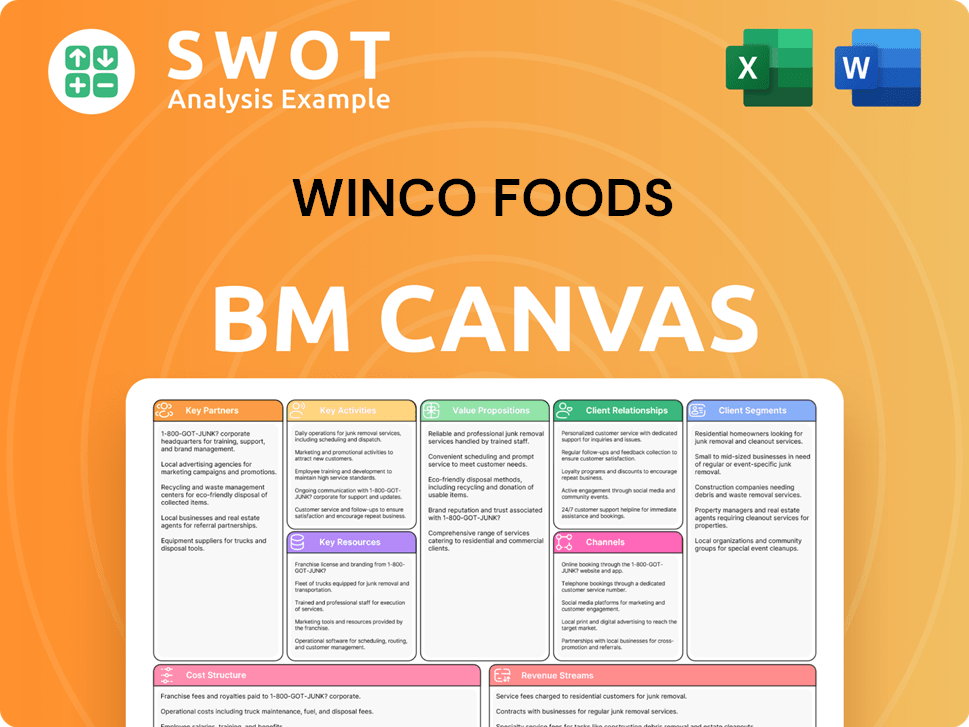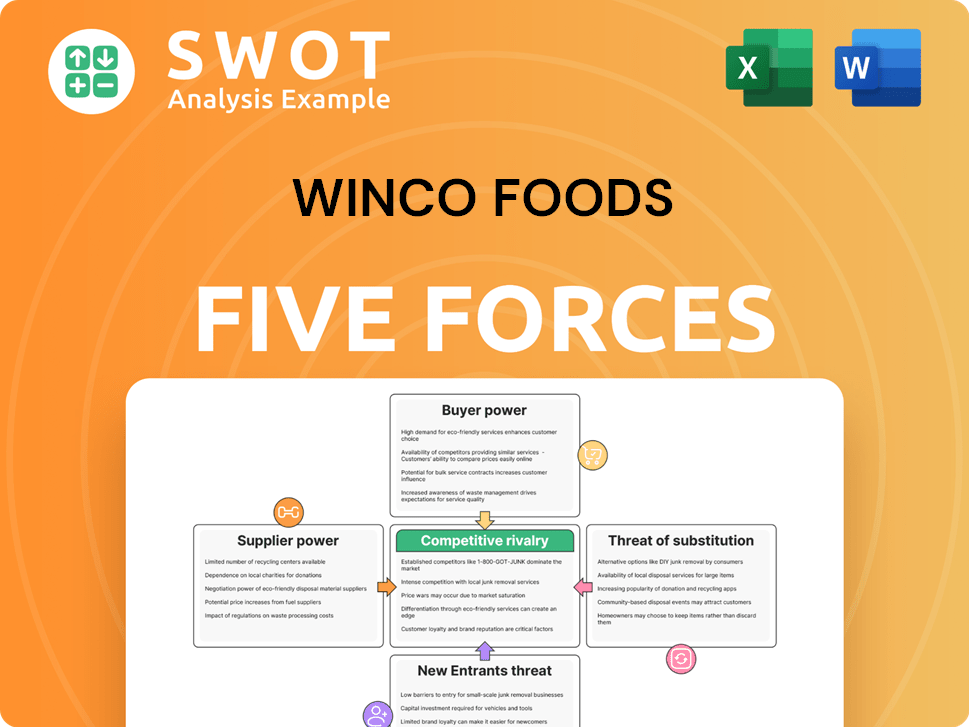WinCo Foods Bundle
How Did WinCo Foods Become a Grocery Giant?
Discover the compelling WinCo Foods SWOT Analysis and the remarkable story of WinCo Foods, a grocery store chain that defied industry norms. Founded in 1967, WinCo Foods began with a simple yet powerful vision: to offer low prices and a unique employee-owned structure. This approach has allowed WinCo to thrive in a competitive market.

From its humble beginnings, the WinCo Foods company has expanded to become a major player in the discount supermarket sector, proving the success of its employee-owned business model. This article delves into the brief history of WinCo Foods, exploring its origin story, strategic decisions, and the factors that have fueled its impressive growth. Learn about the key milestones that have shaped WinCo Foods and its enduring commitment to providing value to its customers.
What is the WinCo Foods Founding Story?
The story of WinCo Foods, a prominent player in the grocery retail sector, began on July 17, 1967. Ralph Ward and Bud Williams established the company in Boise, Idaho, with a clear vision: to offer high-quality groceries at significantly lower prices than traditional supermarkets. This marked the inception of what would become a successful discount grocery store chain.
Their concept was rooted in a no-frills, warehouse-style shopping experience. This approach directly addressed the need for more affordable grocery options. The founders aimed to prioritize savings for consumers over extensive services or elaborate store aesthetics, setting the stage for a unique business model.
WinCo Foods' journey started with a simple yet effective strategy: offering high-quality products at reduced prices. The company's early years were marked by a focus on efficiency and customer value.
- WinCo Foods was founded on July 17, 1967, in Boise, Idaho.
- The initial name was Waremart, reflecting its warehouse-style approach.
- The company adopted the name WinCo Foods in 1999.
- The business model emphasized buying in bulk and minimizing overhead.
The initial business model of the WinCo Foods focused on buying in bulk directly from manufacturers. This approach minimized overhead costs, and the savings were passed directly to the customer. The early product offerings included a wide range of staple grocery items sold in larger quantities to further reduce per-unit costs. Initially known as Waremart, the name reflected its warehouse-style approach to retail. The name WinCo Foods was adopted in 1999, which is an acronym for 'Winning Company', to better reflect its broader offerings beyond just a warehouse concept.
Initial funding for Waremart came from the founders themselves, primarily through bootstrapping and personal investments. This allowed them to maintain full control over their vision and operations from the outset. Early challenges included convincing suppliers to work with their unconventional model and educating consumers about the benefits of a no-frills shopping experience. However, the founders' backgrounds in retail and their understanding of efficient supply chain management were crucial in overcoming these hurdles, laying the groundwork for what would become a highly successful employee-owned enterprise.
The founders' backgrounds in retail and their understanding of efficient supply chain management were crucial in overcoming these hurdles. This laid the groundwork for what would become a highly successful employee-owned enterprise. If you're interested in who WinCo Foods' target market is, you can read more about it in WinCo Foods' Target Market.
WinCo Foods SWOT Analysis
- Complete SWOT Breakdown
- Fully Customizable
- Editable in Excel & Word
- Professional Formatting
- Investor-Ready Format

What Drove the Early Growth of WinCo Foods?
The early growth of WinCo Foods, originally known as Waremart, was marked by a commitment to low prices, which fueled its expansion. Following the opening of its first store in Boise, Idaho, the company strategically expanded within Idaho and into neighboring states. This methodical approach allowed for the refinement of its warehouse-style model and ensured profitability as it entered new markets. This focus on controlled expansion was a key element in the early success of the WinCo Foods Marketing Strategy.
A pivotal moment in the WinCo history was the introduction of its employee stock ownership plan (ESOP) in 1985. This transformation into an employee-owned entity fostered a highly engaged workforce. The ESOP became a cornerstone of WinCo's culture, driving efficiency and customer service. This ownership structure contributed to lower employee turnover and a shared commitment to the company's success.
Throughout the 1980s and 1990s, WinCo Foods continued its expansion, entering markets in Oregon, Washington, California, Nevada, and Utah. This growth was largely organic, driven by the success of existing stores and a growing customer base. The company emphasized bulk purchasing and efficient inventory management, avoiding debt-laden growth strategies. Leadership transitions occurred gradually, maintaining continuity and preserving the company's unique culture.
By the late 1990s, WinCo had established itself as a significant regional player. The name change to WinCo Foods in 1999 signaled its broader market presence and product offerings. This reflected the company's expansion and evolution from its initial focus. This expansion was supported by a strong financial foundation, allowing the company to maintain its competitive pricing strategy.
The company's early success was built on several key strategies. These included a focus on low prices, efficient operations, and a strong employee-ownership culture. WinCo Foods' commitment to bulk purchasing and efficient inventory management allowed it to offer competitive prices. The employee-owned structure fostered a dedicated workforce, contributing to high levels of customer service.
WinCo Foods PESTLE Analysis
- Covers All 6 PESTLE Categories
- No Research Needed – Save Hours of Work
- Built by Experts, Trusted by Consultants
- Instant Download, Ready to Use
- 100% Editable, Fully Customizable

What are the key Milestones in WinCo Foods history?
The WinCo Foods journey is marked by significant milestones, from its early years to becoming a major player in the grocery store industry. The company's evolution reflects strategic decisions and adaptations to the changing retail landscape, solidifying its position as a leading discount supermarket.
| Year | Milestone |
|---|---|
| 1967 | Founded as Waremart, marking the beginning of the WinCo history. |
| 1985 | Transitioned to 100% employee ownership through an Employee Stock Ownership Plan (ESOP), a pivotal moment for the company. |
| 1999 | The company officially changed its name to WinCo Foods. |
| 2023 | WinCo Foods operates over 140 stores across the United States, demonstrating significant expansion. |
WinCo Foods has consistently embraced innovation to maintain its competitive edge. A key strategy was the implementation of a self-distribution model, which allowed for greater control over the supply chain and cost reduction.
WinCo Foods established its own distribution centers and transportation fleet to manage its supply chain efficiently. This approach enabled the company to reduce costs and ensure the freshness of its products, setting it apart from competitors.
The company implemented a sophisticated inventory management system to minimize waste and optimize stock levels. This system contributes to the overall cost-saving strategy by ensuring that products are available when needed and reducing losses due to spoilage.
Despite its successes, WinCo Foods faces several challenges in the competitive grocery market. The need to balance low prices with the rising demand for organic and specialty products presents a strategic hurdle.
The grocery industry is highly competitive, with discounters and online retailers constantly vying for market share. This intense competition puts pressure on profit margins, requiring WinCo Foods to continually seek efficiencies.
Evolving consumer preferences, such as the growing demand for organic and specialty products, require strategic adjustments. Maintaining its low-price model while expanding its product selection to meet these demands is a key challenge.
Managing rapid expansion while preserving its unique employee-centric culture is crucial. The company must ensure that its growth does not dilute its core values or impact its operational efficiency.
WinCo Foods Business Model Canvas
- Complete 9-Block Business Model Canvas
- Effortlessly Communicate Your Business Strategy
- Investor-Ready BMC Format
- 100% Editable and Customizable
- Clear and Structured Layout

What is the Timeline of Key Events for WinCo Foods?
The WinCo Foods story is a journey of strategic decisions and consistent growth, starting with its foundation as Waremart in 1967. The company's transition to employee ownership in 1985 marked a significant shift, followed by a rebranding to WinCo Foods in 1999, reflecting its evolving identity. Expansion into new states, including Texas in 2007, and continuous store openings throughout the 2010s solidified its position as a major regional grocery chain. Navigating the challenges of the COVID-19 pandemic in 2020, the company adapted its operations to meet increased demand, and in 2024, it operates over 130 stores across 10 states.
| Year | Key Event |
|---|---|
| 1967 | Founded as Waremart in Boise, Idaho, by Ralph Ward and Bud Williams. |
| 1985 | Established its Employee Stock Ownership Plan (ESOP), beginning its transition to employee ownership. |
| 1999 | Rebranded from Waremart to WinCo Foods, reflecting its expanding presence and product range. |
| 2007 | Opened its first stores in Texas, marking a major geographical expansion outside its traditional Western U.S. base. |
| 2014 | Celebrated 50 years of operation, highlighting its longevity and consistent growth. |
| 2020 | Navigated the challenges of the COVID-19 pandemic, adapting operations to meet increased demand and safety protocols. |
| 2024 | Operates over 130 stores across 10 states, primarily in the Western United States. |
WinCo Foods is likely to continue its growth, focusing on strategic expansion rather than rapid store openings. The company's future plans involve optimizing its supply chain and distribution network to maintain its cost advantage. Measured expansion into new markets, where its low-price, warehouse-style model can effectively compete, is anticipated. The company's employee-ownership model and its commitment to low prices will remain central to its future direction.
Industry trends, such as the increasing demand for online grocery services and evolving consumer preferences for healthy and sustainable products, will influence WinCo's future strategies. While the company has historically focused on in-store experiences, it may cautiously explore e-commerce options or partnerships. This adaptation will help WinCo Foods stay competitive and meet changing shopping habits.
WinCo Foods Porter's Five Forces Analysis
- Covers All 5 Competitive Forces in Detail
- Structured for Consultants, Students, and Founders
- 100% Editable in Microsoft Word & Excel
- Instant Digital Download – Use Immediately
- Compatible with Mac & PC – Fully Unlocked

Related Blogs
- What is Competitive Landscape of WinCo Foods Company?
- What is Growth Strategy and Future Prospects of WinCo Foods Company?
- How Does WinCo Foods Company Work?
- What is Sales and Marketing Strategy of WinCo Foods Company?
- What is Brief History of WinCo Foods Company?
- Who Owns WinCo Foods Company?
- What is Customer Demographics and Target Market of WinCo Foods Company?
Disclaimer
All information, articles, and product details provided on this website are for general informational and educational purposes only. We do not claim any ownership over, nor do we intend to infringe upon, any trademarks, copyrights, logos, brand names, or other intellectual property mentioned or depicted on this site. Such intellectual property remains the property of its respective owners, and any references here are made solely for identification or informational purposes, without implying any affiliation, endorsement, or partnership.
We make no representations or warranties, express or implied, regarding the accuracy, completeness, or suitability of any content or products presented. Nothing on this website should be construed as legal, tax, investment, financial, medical, or other professional advice. In addition, no part of this site—including articles or product references—constitutes a solicitation, recommendation, endorsement, advertisement, or offer to buy or sell any securities, franchises, or other financial instruments, particularly in jurisdictions where such activity would be unlawful.
All content is of a general nature and may not address the specific circumstances of any individual or entity. It is not a substitute for professional advice or services. Any actions you take based on the information provided here are strictly at your own risk. You accept full responsibility for any decisions or outcomes arising from your use of this website and agree to release us from any liability in connection with your use of, or reliance upon, the content or products found herein.